Yuanting Fan
Towards Fine-Grained Vision-Language Alignment for Few-Shot Anomaly Detection
Oct 30, 2025Abstract:Few-shot anomaly detection (FSAD) methods identify anomalous regions with few known normal samples. Most existing methods rely on the generalization ability of pre-trained vision-language models (VLMs) to recognize potentially anomalous regions through feature similarity between text descriptions and images. However, due to the lack of detailed textual descriptions, these methods can only pre-define image-level descriptions to match each visual patch token to identify potential anomalous regions, which leads to the semantic misalignment between image descriptions and patch-level visual anomalies, achieving sub-optimal localization performance. To address the above issues, we propose the Multi-Level Fine-Grained Semantic Caption (MFSC) to provide multi-level and fine-grained textual descriptions for existing anomaly detection datasets with automatic construction pipeline. Based on the MFSC, we propose a novel framework named FineGrainedAD to improve anomaly localization performance, which consists of two components: Multi-Level Learnable Prompt (MLLP) and Multi-Level Semantic Alignment (MLSA). MLLP introduces fine-grained semantics into multi-level learnable prompts through automatic replacement and concatenation mechanism, while MLSA designs region aggregation strategy and multi-level alignment training to facilitate learnable prompts better align with corresponding visual regions. Experiments demonstrate that the proposed FineGrainedAD achieves superior overall performance in few-shot settings on MVTec-AD and VisA datasets.
TSAL: Few-shot Text Segmentation Based on Attribute Learning
Apr 15, 2025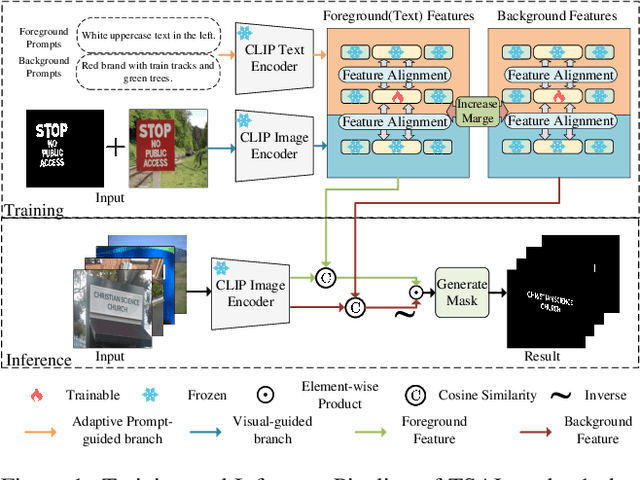

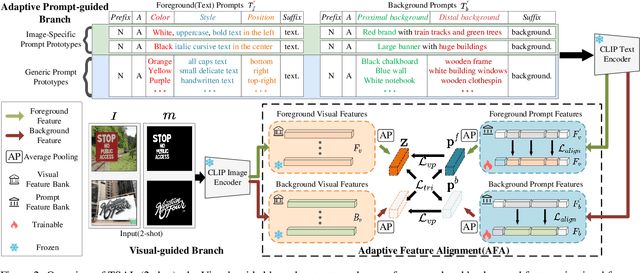
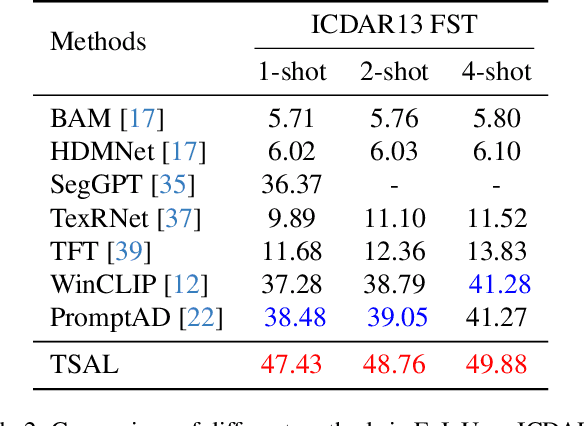
Abstract:Recently supervised learning rapidly develops in scene text segmentation. However, the lack of high-quality datasets and the high cost of pixel annotation greatly limit the development of them. Considering the well-performed few-shot learning methods for downstream tasks, we investigate the application of the few-shot learning method to scene text segmentation. We propose TSAL, which leverages CLIP's prior knowledge to learn text attributes for segmentation. To fully utilize the semantic and texture information in the image, a visual-guided branch is proposed to separately extract text and background features. To reduce data dependency and improve text detection accuracy, the adaptive prompt-guided branch employs effective adaptive prompt templates to capture various text attributes. To enable adaptive prompts capture distinctive text features and complex background distribution, we propose Adaptive Feature Alignment module(AFA). By aligning learnable tokens of different attributes with visual features and prompt prototypes, AFA enables adaptive prompts to capture both general and distinctive attribute information. TSAL can capture the unique attributes of text and achieve precise segmentation using only few images. Experiments demonstrate that our method achieves SOTA performance on multiple text segmentation datasets under few-shot settings and show great potential in text-related domains.
AdaDiffSR: Adaptive Region-aware Dynamic Acceleration Diffusion Model for Real-World Image Super-Resolution
Oct 23, 2024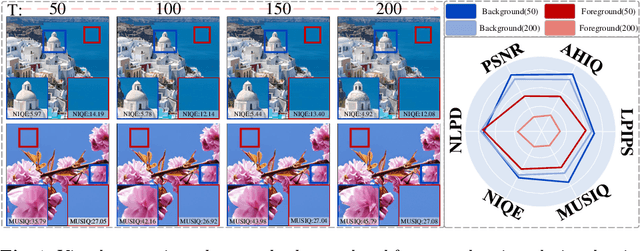
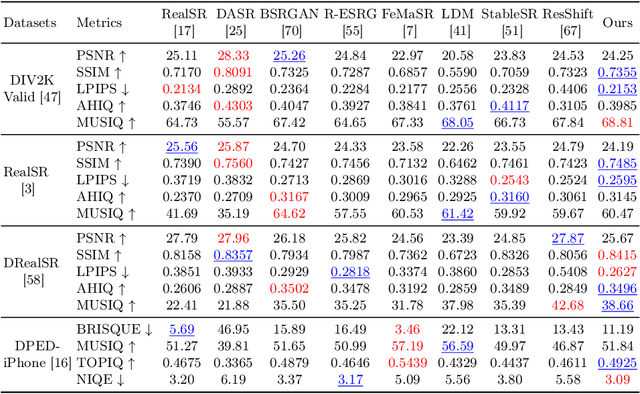

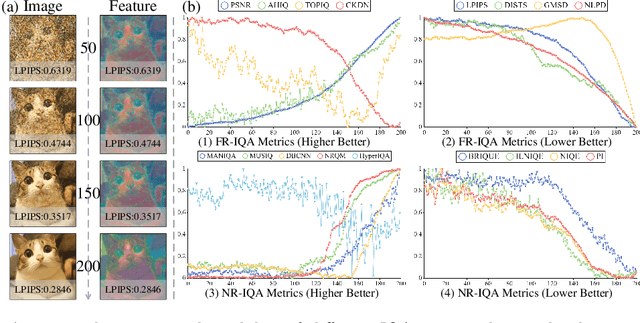
Abstract:Diffusion models (DMs) have shown promising results on single-image super-resolution and other image-to-image translation tasks. Benefiting from more computational resources and longer inference times, they are able to yield more realistic images. Existing DMs-based super-resolution methods try to achieve an overall average recovery over all regions via iterative refinement, ignoring the consideration that different input image regions require different timesteps to reconstruct. In this work, we notice that previous DMs-based super-resolution methods suffer from wasting computational resources to reconstruct invisible details. To further improve the utilization of computational resources, we propose AdaDiffSR, a DMs-based SR pipeline with dynamic timesteps sampling strategy (DTSS). Specifically, by introducing the multi-metrics latent entropy module (MMLE), we can achieve dynamic perception of the latent spatial information gain during the denoising process, thereby guiding the dynamic selection of the timesteps. In addition, we adopt a progressive feature injection module (PFJ), which dynamically injects the original image features into the denoising process based on the current information gain, so as to generate images with both fidelity and realism. Experiments show that our AdaDiffSR achieves comparable performance over current state-of-the-art DMs-based SR methods while consuming less computational resources and inference time on both synthetic and real-world datasets.
Decoupling Degradations with Recurrent Network for Video Restoration in Under-Display Camera
Mar 08, 2024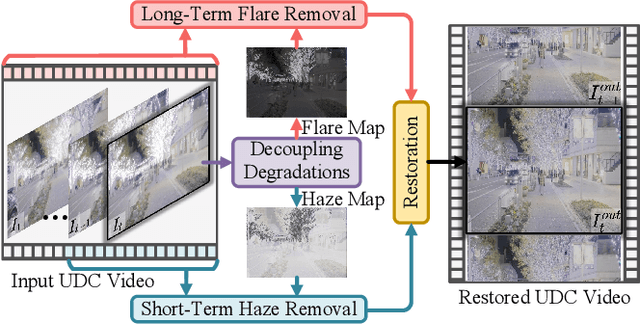
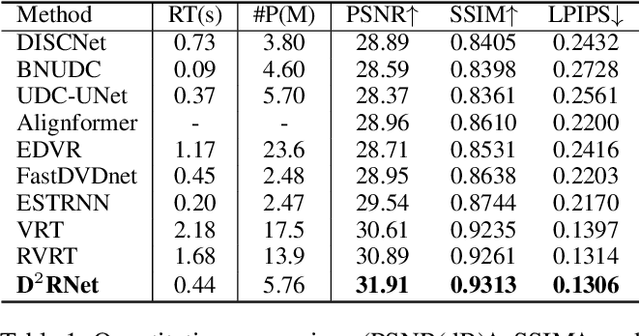

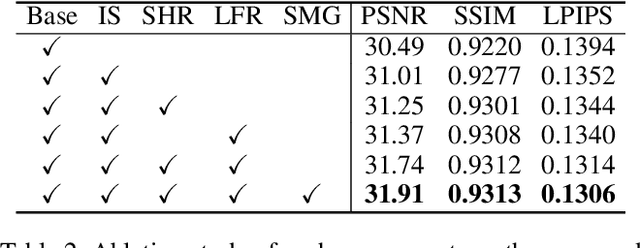
Abstract:Under-display camera (UDC) systems are the foundation of full-screen display devices in which the lens mounts under the display. The pixel array of light-emitting diodes used for display diffracts and attenuates incident light, causing various degradations as the light intensity changes. Unlike general video restoration which recovers video by treating different degradation factors equally, video restoration for UDC systems is more challenging that concerns removing diverse degradation over time while preserving temporal consistency. In this paper, we introduce a novel video restoration network, called D$^2$RNet, specifically designed for UDC systems. It employs a set of Decoupling Attention Modules (DAM) that effectively separate the various video degradation factors. More specifically, a soft mask generation function is proposed to formulate each frame into flare and haze based on the diffraction arising from incident light of different intensities, followed by the proposed flare and haze removal components that leverage long- and short-term feature learning to handle the respective degradations. Such a design offers an targeted and effective solution to eliminating various types of degradation in UDC systems. We further extend our design into multi-scale to overcome the scale-changing of degradation that often occur in long-range videos. To demonstrate the superiority of D$^2$RNet, we propose a large-scale UDC video benchmark by gathering HDR videos and generating realistically degraded videos using the point spread function measured by a commercial UDC system. Extensive quantitative and qualitative evaluations demonstrate the superiority of D$^2$RNet compared to other state-of-the-art video restoration and UDC image restoration methods. Code is available at https://github.com/ChengxuLiu/DDRNet.git
 Add to Chrome
Add to Chrome Add to Firefox
Add to Firefox Add to Edge
Add to Edge